The term xingju 刑具, translatable as "penal instruments" or "torture instruments", were types of equipment used in ancient China to torture and detain criminals or to execute corporal punishment. These instruments were directly related to the judicial system of the time, and thus differed over the ages. Torture was a common method of producing confessions or testimonies during criminal interrogations (xingxun 刑訊). Brook, Bourgon and Blue (2008: 9, 43) differentiate between torture, by which suffering is intended to cause suspects to confess, and torment, a type of suffering of the condemned that is intended to make an impression on onlookers.
The chapter on penal justice (23 Xingfa zhi 刑法志) in the official dynastic history Hanshu 漢書 explains that in ancient times, severe punishment (daxing 大刑) consisted of military service (? jiabing 甲兵, or penal labour in the production of weaponry) or decapitation (fuyue 斧鉞, see death penalty), average punishment (zhongxing 中刑) by applying knives and saws (dao ju 刀鋸) for amputation of body parts or needles (zuan zao 鑽鑿) for tattooing, and minor punishment (boxing 薄刑) of flogging and beating (bian zhang 鞭杖). Early inscriptions on oracle bones and bronze vessels prove the use of tools to fetter the feet (zhi 桎), to fetter both hands (gong 拲), and to fetter one hand (gu 梏). Pottery figurines found in Shang-period 商 (17th-11th cent. BCE) graves show men and females with fettered hands. The ritual Classic Zhouli 周禮 (part Qiuguan 秋官, ch. Zhangqiu 掌囚) explains that criminals having committed dangerous offences (shangzui 上罪) were detained with two-hand fetters (gong), feet shackles (zhi), and manacles for one hand (gu); perpetrators with average crime records (zhongzui 中罪) by shackles and manacles for hands and feet (zhi gu); and delinquents with light crimes (xiazui 下罪) just by manacles for the hands (gu).
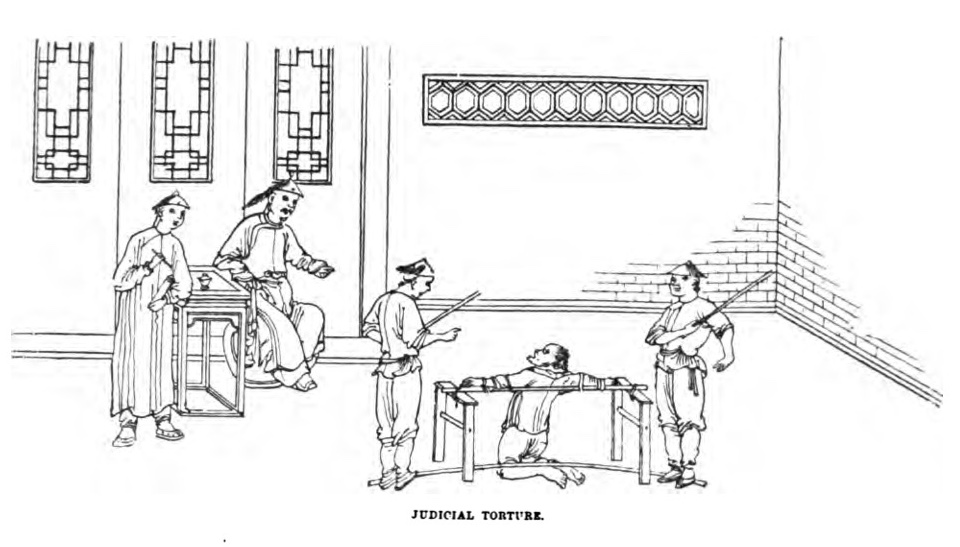 |
|
The delinquent is tied to a construction forcing him to kneel down, while ushers are flogging his arms. The district magistrate, sitting in the background, is waiting for confession. Source: Gray & Gregor 1878. |
|
With the abolishment of the five penalties of mutilation (rouxing 肉刑, see five punishments wuxing 五刑) in the early imperial age, the use of penal tools changed accordingly. The imperial dynasties discerned between legally stipulated tools, and extra-legal tools, of which a wide range was in use. The most important legal ones were the cangue (jia 枷), fetters for hand and feet (chou 杻), neck and leg irons (qian di 鉗釱), chains (suo 鎖), the heavy stick (zhang 杖), the light stick (chi 笞), the whip (bian 鞭), leg squeezers (jiagun 夾棍) and finger squeezers (zanzhi 拶指).
"Handcuffs" and shackles (chou 杻, also called chouxie 杽械), belonged to the oldest types of detaining criminals. Gu 梏 were used to fetter the hands, and zhi 桎 (also called xie 械) to hold together the feet. In case a criminal was forced to wear both, the term zhi-gu 桎梏 (first attested in the Classic Yijing 易經 "Book of Changes", hexagram meng ䷃ 蒙) was used. The origin of these instrument is variously credited to the Yellow Emperor 黃帝, his opponent Chi You 蚩尤, or the evil king Zhou 紂 of the Shang dynasty. Details on the dimensions of these types of fetters were fixed in the penal code of the Liang dynasty (梁 (502-557), Lianglü 梁律, as mentioned in the chapter on penal justice (ch. 25) in the official dynastic history Suishu 隋書. The Liang discerned between xie 械, chou 杻, shengxie 升械, and leg irons (di 釱). The Northern Dynasties 北朝 (386~581) used particularly large forms (gaochou 高杻) to detain rebels and insurgents. The chapter on penal law (ch. 50) in the Jiutangshu 舊唐書 likewise says that all tools to detain criminals had different sizes adapted to the seriousness of the crime. According to the administrative regulations Tangliudian 唐六典, a wooden block of hand shackles had a size of 1.6-2 chi ("feet", see weights and measures) and a thickness of 1 cun ("inch"). The code of the Ming dynasty 明 (1368-1644), Minglü 明律, stipulated the use of a wooden board with a length of 1.6 chi and a thickness of 1 cun. It was worn by males sentenced to death, but not by females, and not by persons sentenced to exile (liu 流) and lesser forms of punishment. During that time, the shackles were for the first time made of iron (called kao 𨯕).
Iron chains (suo 鎖, also written 鏁 and called tiesuo 鐵索 or tielian 鐵鏈) were first used during the Former Han period 前漢 (206 BCE-8 CE). Nearly all dynasties regulated the dimensions and use of iron chains. The law code of the Chen dynasty 陳 (557-589) stipulated that persons sentenced to five years of heavy punishment (including a shaved head and flogging), just one step lower than the death penalty, had to bear a double chain (suo er chong 鎖二重). Persons sentenced to do penal labour had to wear a neck chain anyway. During the Yuan period 元 (1279-1368), the term suo 鎖 was used for chains around the neck (jiaxiangsuo 夾項鎖), and liao 鐐 to such attached to the legs. The former had a length of between 8 and 12 chi, while the latter had a weight of 3 jin 斤 ("pounds"). The Ming Code (ch. Yuju tu 獄具圖) fixed the length of an iron chain at 1 zhang ("fathom"). It was used for delinquents sentenced to light penalty (fan qing zui ren 犯輕罪人), while the foot chain was particularly used for criminals sentenced to do penal servitude (tu 徒).
Neck and leg irons (qian di 鉗釱) were used in early imperial times as a substitute for mutilation. Qian were tied to the neck, and di to the feet. Archaeologists found numerous irons in tombs of the late Warring States 戰國 (5th cent.-221 BCE) and the Han period. Neck irons had a weight of 2 jin and had an upright handle (qiao 翹) of 1.5 chi of length, as the code Jinlü 晉律 and tomb findings prove. Persons forced to do penal servitude were usually restricted by neck irons, and were also shaved their heads (kun 髡 or 髠). In addition to that, the labour period began with a certain number of lashes with the whip. The warlord Cao Cao 曹操 (155-220), issuing the Jiazi regulation (Jiazi ke 甲子科), had neck irons made of wood because iron was a scarce material at the time. During the Sui period 隋 (581-618), different sizes of neck irons were known and applied for different grades of crime. The regulations of the Tangliudian from the Tang period 唐 (618-907) stipulated that the neck iron was used for delinquents punished to exile or penal servitude. Legal regulations concerning the dimensions of the neck iron are still found in Song-period 宋 (960-1279) sources. Leg irons (also called ta 錔) are first mentioned in the book Guanzi 管子 (ch. Youguan 幼官). Archaeology has shown that leg irons were tied to chains whose links had a size of 9 × 11 cm (Lu 2004: 74). The irons were tied to the left foot and had a weight of 800-1100 g, which contrasts with the statement "6 jin" in the book Shiji 史記 (30 Pingzhun shu 平準書). Both types of fetters became obsolete from the Yuan period on.
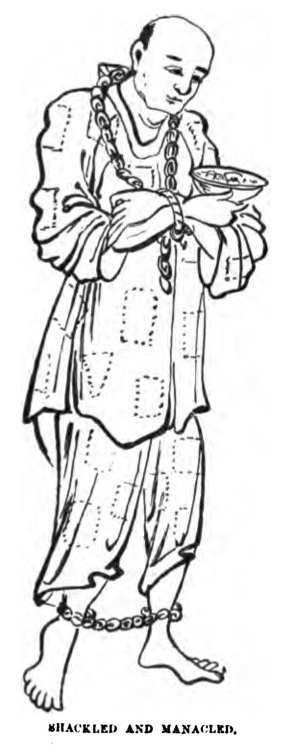 |
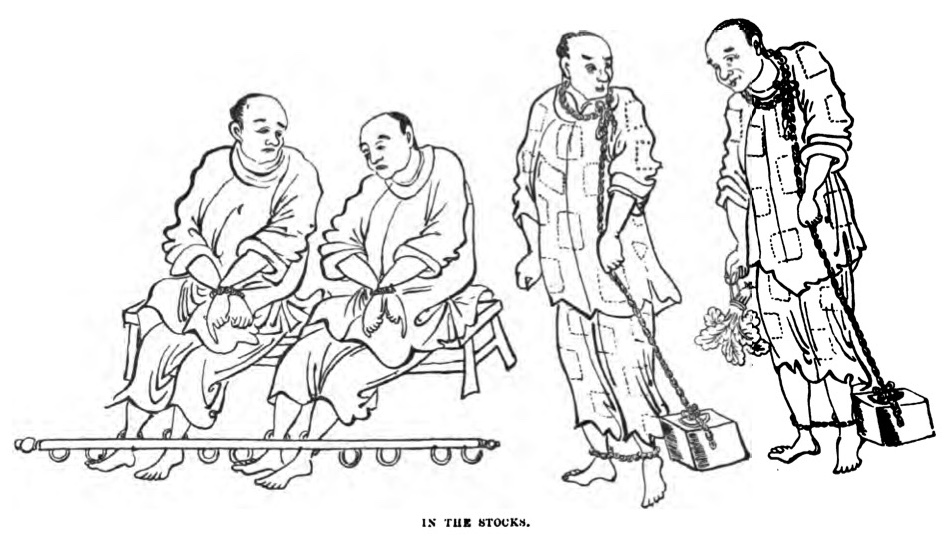 |
The person on the left image wears neck and foot irons and is forced to wander around like a mendicant. The right image shows delinquents with feet in the stock or with neck chains tied to a stone or metal block. Source: Gray & Gregor 1878. |
|
Instead of neck irons, the wooden cangue became a widespread instrument used to detain and shame criminals in public. It is known as a square wooden board worn around the neck during late imperial times. The word jia 枷 is first mentioned in Jin-period 晉 (265-420) sources, even if similar tools were known as early as the Qin 秦 (221-206 BCE) and Han periods. At that time, they were called "three wooden [tools]" (sanmu 三木) or "wooden tool" (xie 械). The word cangue is derived from the French version of the Portuguese word for "yoke", canga. The laws of the Northern Wei 北魏 (386-534) reserved the cangue for rebels and usurpers. It was a square of 1,3 zhang of width and 1 zhang of length, and in the middle a hole for the neck, with a width of 5 cun. The Northern Qi 北齊 (550-577) used the cangue as a replacement for iron chains. The Northern Zhou 北周 (557-581) ordered that criminals sentenced to death, exile, and penal servitude, had to wear the cangue. During the Tang period, the instrument was known as panjia 盤枷. Some notoriously cruel officials made use of ten different sizes of cangues. From the Song period on the courts discerned between three sizes, ranging from 15 to 25 jin of weight. The Ming Code explains that the heavy one was worn by persons to be executed, the 20-jin cangue by persons sentenced to exile and penal servitude, and the light one of 15 jin by persons to be beaten in public. Typical offences punished with the cangue were robbery and theft (qiedao 竊盜), adultery (fanjian 犯奸), gambling (dubo 賭博), and desertion from the army or the exile. In 1669, the Kangxi Emperor 康熙帝 (r. 1661-1722) decreed the abolishing of the "long cangue" (changjia 長枷) to detain criminals. It was replaced by iron chains. From then on, the cangue was only used as a tool of varying size (jiahao 枷號) used to punish physically and for public shaming. The weight of the cangue first ranged between 60 and 70 jin, but was in 1740 basically reduced to the standard size of 25-30 jin, even if heaver models remained in practical use. The cangue was also applied to Bannermen which were otherwise spared severe punishment or even exile.
There was also use of a two-parts or double cangue (lianjia 連枷) applied to the left and right sides of the neck. An image of a Northern Zhou-period cangue was found on a Dunhuang 敦煌 manuscript (Shiwu jing tujuan十五經圖卷. Another use was to tie together two or even three persons with one single instrument. This custom was applied to enslaved war captives, as during the Sixteen States period 十六國 (300~430), or for criminals, as during the late Qing period 清 (1644-1911).
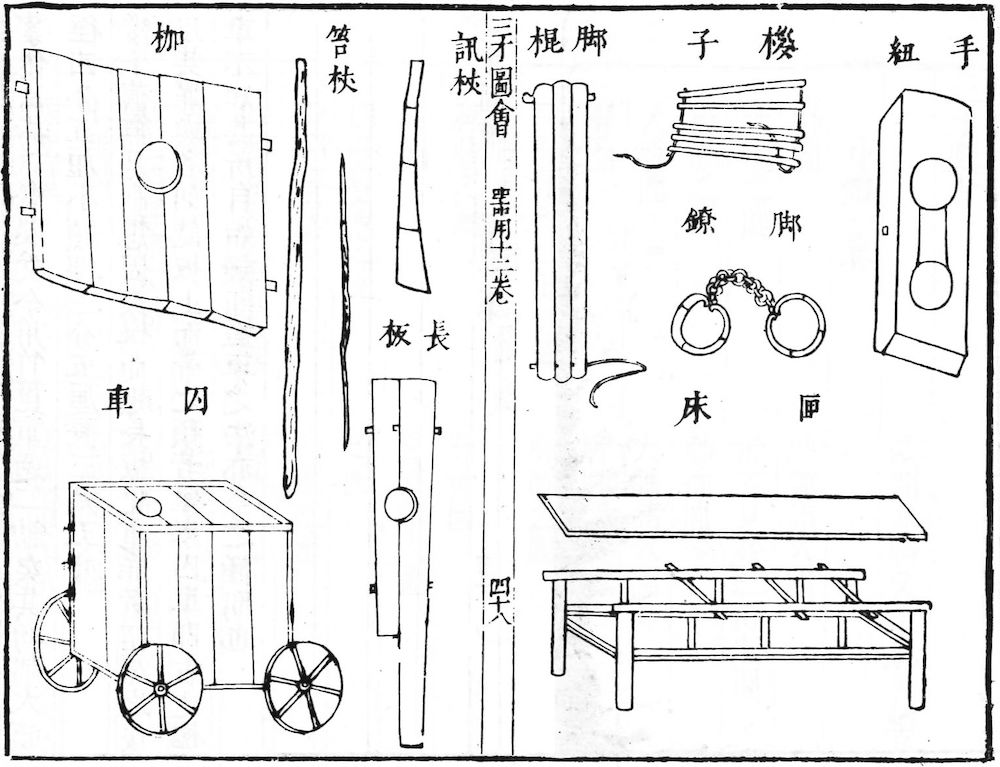 |
Image from the Ming-period encyclopaedia Sancai tuhui 三才圖會, Qiyong 器用 11, fol. 48, showing wooden hand shackles (shoujiu 手紐, right top), iron foot locks (jiaoliao 腳鐐), finger (zanzi 桚子) and leg (jiaogun 腳棍) squeezers, a "box bed" (xiachuang 匣床, bottom right), a light stick made of vitex and a heavy one (chi zhang 笞杖), a flat board to beat during interrogations (xunzhang 訊杖), a long board to enclose the neck (changzhang 長杖), a cangue (jia 枷, left top), and a cart to transport prisoners (qiuche 囚車, left bottom). |
"Box beds" (xiachuang 㭱牀) served to prevent prisoners to escape or kill themselves. The expression is first attested for the Five Dynasties period 五代 (907-960). Lü Kun 呂坤 (1536-1618) describes the details of the instrument as used during the late Ming period. The prisoner was tied to the "bed" with several iron chains, while the abdomen and the legs were pressed down by wooden balks. The delinquent was definitely brought down by a cover studded with sharp points to restrict the movement of the body. This cruel instrument was abolished by the Qing.
The heavy stick (zhang 杖) was either used as an instrument to extort confession or as a tool to execute punishment. It was made of wood, bamboo, or rods of the vitex (jingtiao 荊條). Under the Qin dynasty, it was called bangchi 榜笞. In 156, the Han dynasty decreed the "Scourge law" (Chuiling 箠令) which fixed exactly the dimensions of the instrument: Length 5 chi, thickness 1 cun at the lower part, and in case of bamboo, flattened nodia. The execution of strokes could be performed by one person. The Tang dynasty fixed the length at 3.5 chi and the thickness between 3.2 and 2.2 fen. Strokes should be distributed over the back, the legs, and the buttocks of the delinquent. The Tang law even limited the strokes to three rounds for interrogations and two hundred strokes in total. The amount was different in case of executing punishment (see heavy stick). The Ming dynasty had the "interrogation stick" (xunzhang 訊杖) made of vitex of a length of 3.5 chi and a thickness of between 3.5 and 4.5 fen. The stick was applied to the buttocks.
Apart from this legally defined stick, the courts in China used various kinds of cudgels or clubs to extort confession or testimonies. The chapter on penal jurisdiction in the Suishu lists truncheons (dabang 大棒), lashed rods (shuzhang 束杖), wheel spokes (chefu 車輻), shoe soles (xidi 鞵底) and various sticks (zhangguang 杖桄, tinggun 挺棍) used to beat suspects and tormenting them.
Whips (bian 鞭) have long history and are attested in the Classic Shangshu 尚書 "Book of Documents" (ch. Yaodian 舜典) and the inscription of Western Zhou-period 西周 (11th cent.-770 BCE) bronze vessels like Sheng yi 𠑇匜 and Wei ding 衛鼎 (written 𠓠). During that time, scourges were made of vitex, but in imperial times, cowhides were used to produce penal whips. Whips were also used by market supervisors (sishi 司市) and royal guards to drive people out of the way of the king's coach. In early imperial times, sticks (pu 撲) were made of date twigs or cane, even if the sources use the word bian, which actually refers to a leather whip. During the Han period, sticks to beat with were made a legal tool for punishment. The penal code Jinling 晉令 from the Jin period even determined the exact size of the strap. Heavy crimes were punished with 50 strokes of the leather whip, minor ones with 20, but the penal code Jin zhongxing shu 晉中興書 (quoted in the encyclopaedia Taiping yulan 太平御覽) speaks of 100 or even 200 lashes. The code of the Liang dynasty discerned between whips of raw and unsmoothened hide (zhibian 制鞭), such of smoothened, but raw hides (fabian 法鞭), and such of cooked, but unsmoothened leather (changbian 常鞭). Whips were usually combined with light sticks (xiaozhang 小杖), with the stick being applied first. The penal code of the Northern Wei fixed the length of a whip, and made flogging an additional punishment (fujia xing 附加刑) for persons sentenced to exile. The Northern Qi abolished the raw-hide whip to avoid excessive loss of blood. There were usually five scales of flogging, with increasing numbers of lashes, but limited to a number of 100. Flogging was abolished by the Sui dynasty in 581, and was afterwards only in use in the Liao empire 遼 (907-1125) under the name bianluo 鞭烙 "whip-roasting (i.e. torturing)".
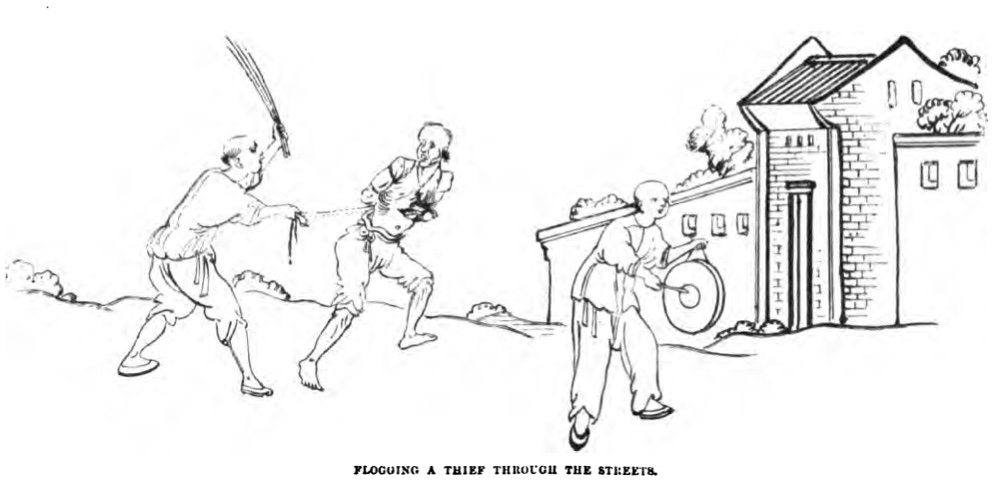 |
|
The court ushers drive a thief through the streets while flogging him. One of them beats a gong to announce the event to attract spectators and expose the criminal to public shaming. Source: Gray & Gregor 1878. |
|
Leg squeezers (jiagun 夾棍 or 梜棍, jiabang 夾幫, jiabang 夾棒, tuijia 腿夾, jiaojia 腳夾, cuncunjin 寸寸緊) were prevalent during the Song period, but were used until the end of the imperial era. The Han-period term ya 軋, the early word yahuai 壓踝, or the Tang-period term daguan 大關 might refer to a similar tool. Because the tortured persons, lying on the ground face-down, usually lifted their bodies out of pain, the instrument also had the name chaogun 超棍 "jump stick".
The tool was once illegally used by the notorious Brocade Guard (jinyiwei 錦衣衛) of the Ming-period eunuch clique. Huang Yu's 黃煜 book Bixuelu 碧血錄 describes the torture instrument. It consisted of two 3-chi-long sticks of poplar wood tied to the right leg of the delinquent who was lying on the ground. The squeezed leg was held upright, while court ushers wildly stroke against the wood. During the Qing period, the instrument was legalized, but was only applied to male dangerous criminals. The instrument consisted of three 3-chi-long sticks of wood (hence the name sanchi 三尺 or sanchimu 三尺木) that were round at the top and square at the bottom. Both legs were thus squeezed between the sticks, while pressure could be regulated by ropes. One stick was stuck between the two legs, and one on each outer side of the legs. Deviating sizes or special modes of application were illegal. The sticks were used for "squeezer" interrogations (jiaxun 夾訊). A judge using the leg squeezer for women risked dismissal. The instrument was not allowed to be applied more than twice to the same person.
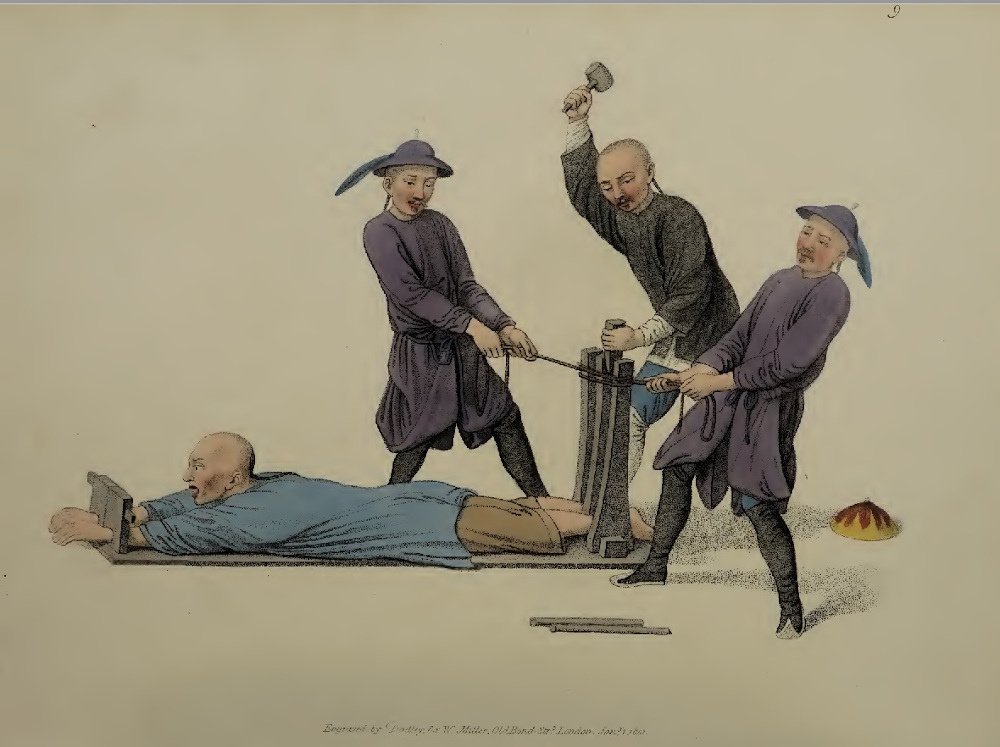 |
"The Rack". Source: Mason 1801. |
Finger squeezers (zanzhi 拶指, zanzi 拶子, also written 桚, also named shu tan zheng 鼠彈箏 "the rat plays the zither") came into widespread use during the Qing period, even if they are attested for the Northern Qi dynasty with the name jiazhi 夾指. Lü Kun's Shizhenglu 實政錄, a book on district administration, says that the finger squeezers were actually not legal, but found entrance to the courts during the Ming period, and soon became popular. They consisted of five round wooden sticks of 7 cun of length and 0.45-0.5 cun diameter. The fingers of the delinquent were stuck in-between. The sticks were tied by a rope at which ends two court ushers used to pull in order to squeeze the fingers of the culprit and extort confession or answer. There were light and heavy forms, old and new tools (the latter being sharper), and a custom of applying them wet or dry. The instrument was mainly used for females, as the "leg twisters for women", as the commented administrative glossary Liubu chengyu zhujie 六部成語注解 said. It was not allowed to apply the finger squeezers more than twice for one person in order not to cripple the suspect. It should also be used to solve severe crimes only.
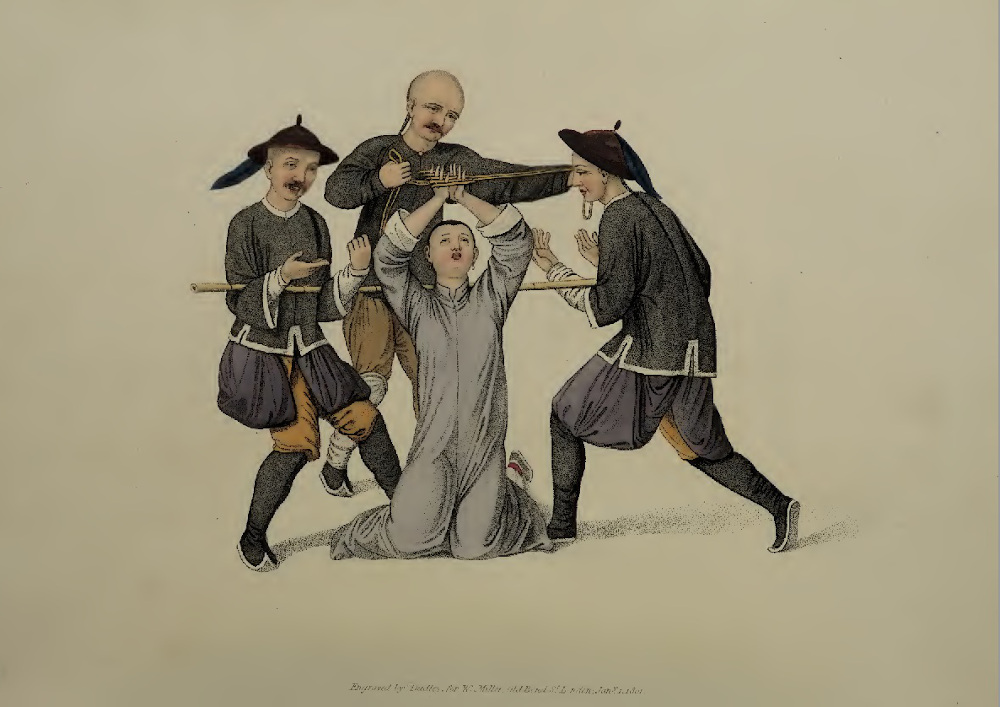 |
"Torturing the Fingers". Source: Mason 1801. |
Ming-period inquisitors knew quite a further range of illegal torture instruments, like the "brain press" (naogu 腦箍, also called tiejuan 鐵圈 or miegu 篾箍), the "roasting iron" (laotie 烙鐵), "one letter" (yi feng shu 一封書, shape and use unknown), the "horse-taming club" (lanmagun 攔馬棍 or 闌馬棍), "swallows fly" (yan'er fei 燕兒飛, appearance and use unknown), sharply pointed bamboo sticks (zhuqian 竹簽) or "bone-grinding nails" (moguding 磨骨釘). The "brain press" consisted of a string, a cow-leather ring, and a bamboo construction. During interrogation, the ushers pulled the string or used other methods to exert pressure around the delinquent's head. During the Ming and Qing periods, the instrument was forbidden, but was nevertheless used here and there. It is first described in the chapter on penal law in the history book Songshi 宋史, and is also mentioned in Xu Yuanrui's 徐元瑞 administrative handbook Lixue zhinan 吏學指南 and Zheng Tingyu's 鄭廷玉 theatre play Houtinghua 後庭花, both from the Yuan period.
In 1912, the Provisional Government of the Republic of China (1912-1949) legally abolished the use of torture as a means of judicial interrogation.